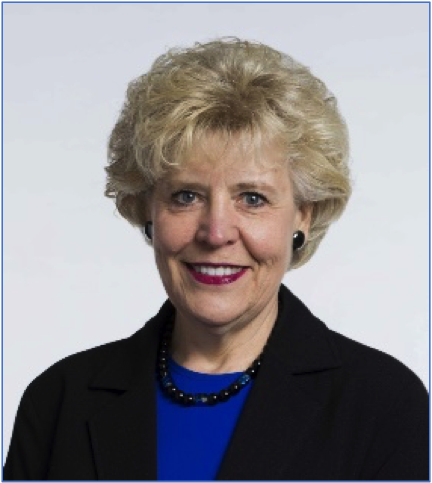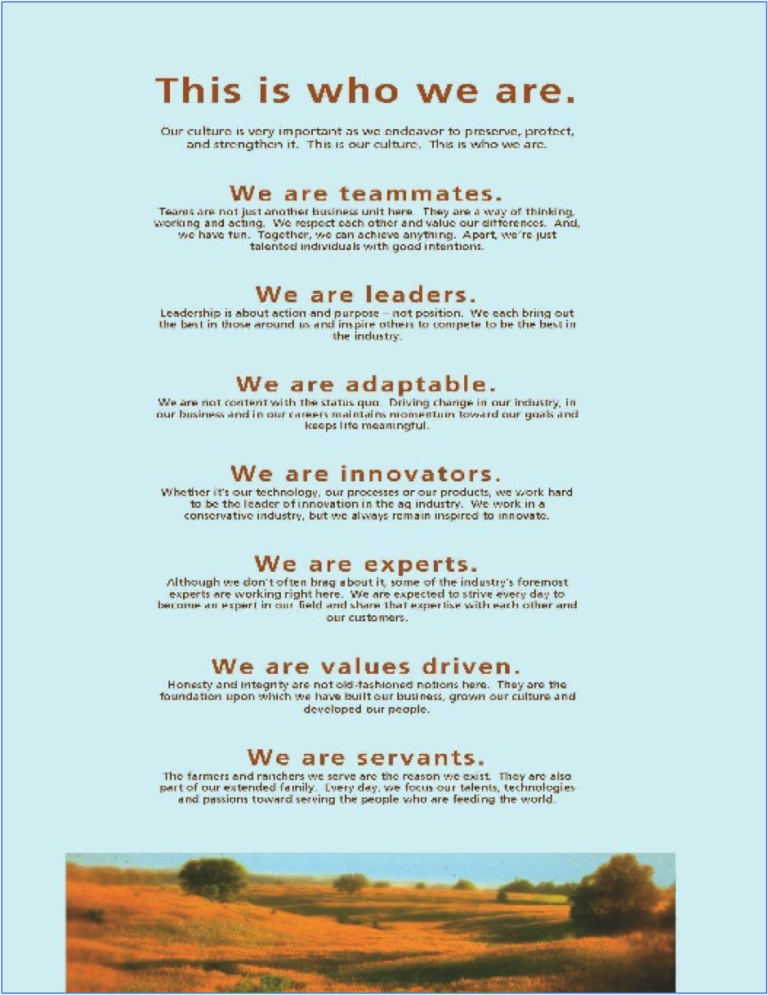In this new series, titled “Stories from the Field,” SageRiver sits down with senior leaders who are transforming their organizations for tomorrow. Their inspiring stories illustrate how leaders and employees are co-creating the organization of the future to achieve greater agility, engagement, innovation and performance. Our first conversation is with Ann Finkner, senior vice president and chief administrative officer of Farm Credit Services of America (FCSA), a customer-owned financial cooperative serving farmers and ranchers in Iowa, Nebraska, South Dakota and Wyoming. FCSA’s holistic approach to becoming a learning organization makes it a national leader in employee engagement.
 You Say You Want a Revolution
You Say You Want a Revolution
Founded in 1916, FCSA has a rich tradition of providing credit services to those who feed the world. Known for its honesty and integrity, the organization serves its members proudly and helps strengthen their farming and ranching operations through good times and bad.
In the late 1990s, FCSA welcomed a new CEO with a passion for organizational development and culture change. His arrival kicked off what Finkner calls a decades-long “cultural revolution” that transformed FCSA from a traditional top-down organization into one that engages all team members in imagining and creating the future. Over the same period, FCSA has more than quadrupled its annual income, which it then reinvests back into serving customers and shares with its customers/stockholders through cash patronage.
Mind Shifts
In those early days, FCSA knew it needed to reconceptualize leaders and teams to become the organization it wanted to be, Finkner says.
Accordingly, FCSA developed a new leadership framework based on the concepts of James M. Kouzes and Barry Z. Posner. The goal was to shift expectations and thinking, so leaders would understand their roles as facilitators, coaches and guides. Rather than manage through top-down directives, leaders were primarily responsible for inspiring a common vision, developing talent and fostering relationships with and among team members. For their part, employees were no longer individual contributors. They were teammates, collaborators and grass-roots leaders focused on shared growth and achievement.
FCSA offered training around these principles, refocused its annual leader meeting around leadership and leadership development, and empowered team members to collaborate in new ways.
“Leaders now had permission to do things differently,” Finkner recalls. “Instead of leading every meeting themselves, for example, they were encouraged to rotate the leadership and develop team ground rules and accountabilities.”
FCSA also retooled some programs to put leaders and team members on more equal footing. Leadership was not about elevated status; it was about accountability and responsibility, Finkner says.
Space Matters
Knowing that the physical environment influences how people think and act, FCSA transformed its workspaces into open settings with casual areas to encourage collaboration and conversation. Leaders work in open offices alongside their team members whenever possible, Finkner says, to strengthen relationships and understand how team members work together. Team members can also gather in conference areas or use enclosed phone booths for private or extended conversations.
FCSA discusses open workspaces in candidate interviews as well, letting applicants know that teamwork is an essential component of FCSA’s culture. That principle is being applied to a new building project at FCSA’s headquarters in Omaha, Nebraska, as well. A cross-functional team of leaders and employees guided the effort to ensure the design supports collaboration and meets essential team needs.
Winning Together
Aligning the compensation structure to team success was another important element of FCSA’s transformation, Finkner says. Annual incentive plans are now entirely team based, with support teams participating with the customer-facing teams they assist. (Individual performance is factored into merit pay.)
“We are a team, not competitors, and we share the same goals,” Finkner says. “We wanted to encourage employees to partner in serving customers and to help everyone win.”
FCSA also eliminated annual performance reviews in favor of more frequent coaching discussions. Leaders facilitate monthly check-ins with team members, as well as more formal semi-annual conversations. Rather than review past performance, however, leaders use inside-out coaching to help employees identify how they can achieve their individual and team goals. Younger employees, who value ongoing feedback and growth, have especially appreciated the stepped-up coaching rhythm.
Teachers Are Everywhere
As FCSA’s evolution continued, a second CEO challenged the organization to think bigger. In addition to being great team members, he wanted FCSA employees to be better people because they worked there.
At FCSA, employee development is driven by experience, exposure and education, at both the individual and team levels. Each team member creates an annual personal development plan as part of annual goal setting. Goals are aligned to each person’s career stage and personal and professional objectives. FCSA also gives employees eight hours of paid volunteer time each year. In addition, employees can take occasional paid personal time to meet family commitments, serve in the community and pursue personal goals.
To support ongoing learning, Finkner’s team also expanded internal training and development opportunities. Employees can now access self-directed learning programs to explore long-term career goals, including future leadership roles. Facilitated trainings are also offered to team members at all levels to support their development. In addition, leaders and employees are encouraged to pursue more coaching, feedback and exposure to other teams and leaders as part of their personal development plans.
True to its team focus, FCSA convenes cross-functional teams to accomplish key objectives. Some of the teams, such as the women and young professionals teams, are standing groups. Others, such as the building design team, have time-limited missions. In addition to driving initiatives forward, the teams give employees the opportunity to learn more about FCSA’s business, build skills through new projects and forge relationships with team members across the organization.
Regular work teams learn and serve together as well. They are asked to complete quarterly activities, including volunteer projects, training sessions, teambuilding activities and celebration events. Employees also connect via online blogs and forums to share interests and ideas and explore mutual learning.
FCSA tracks the impact of these activities via IBM Kenexa, a talent management system that includes employee engagement surveys and analytics. Along with their annual survey results, teams receive a guide that helps them use their information to develop team engagement and business plans to drive continuous improvement. As an enterprise, FCSA consistently achieves among the highest employee engagement scores of all IBM Kenexa customers.
The Story of Us
Over the past 20 years, FCSA employees transformed their organizational culture, which they collaboratively defined in what they call their “We Are” statements. The statements are illustrated on posters throughout FCSA work areas and shared with new employees. In addition, employees develop an annual online publication that showcases what being an FCSA team member looked like during the past year.
 New team members receive what Finkner calls “culture in a box”—literally a box including items that represent aspects of FCSA’s culture. In addition, new hires attend executive-led sessions that explore FCSA values and programs, such as new employee orientation, well-being and leadership development.
New team members receive what Finkner calls “culture in a box”—literally a box including items that represent aspects of FCSA’s culture. In addition, new hires attend executive-led sessions that explore FCSA values and programs, such as new employee orientation, well-being and leadership development.
The culture is strengthened by connecting employees with FCSA members. Each year, employees visit member farming and ranching operations to further connect with the people they serve. FCSA is also involving employees and members in a “Shark Tank”-inspired initiative to create innovative ways to support farmers and ranchers.
Because leaders and employees own the culture together, Finkner says, there is a high degree of trust and transparency. In many ways, she says, the culture evolves organically and fosters mutual accountability based on shared values and expectations.
“New employees will say that our culture just feels different in a good way,” Finkner says. “That type of culture doesn’t just happen, though. You have to work at it and know how to be a team member and lead in that environment.”
Climbing Higher and Higher
As Finkner reflects on FCSA’s journey as a learning organization, she says some lessons are clear.
Employees are more likely to embrace change when they know the business case for new initiatives and can help solve potential challenges. FCSA has also created an expectation of continual learning, and employees know they have a vital voice in FCSA’s evolution.
“It takes time, and you can’t eat the elephant,” Finkner says. “You must decide where the greatest value is and start there. And then, you must continue to push forward, rather than being satisfied with where you are.”
Finkner also stresses the need to rethink leadership. As she has grown as a leader, she spends less and less time on functional responsibilities. Instead, her days are spent listening to stories, facilitating conversations and asking questions to guide development.
“Leadership is less about completing tasks than it is about creating value,” she says. “I’m here to be in service. That is how we add value as leaders.”
If your organization is interested in transforming into a learning organization, contact SageRiver to learn more.





